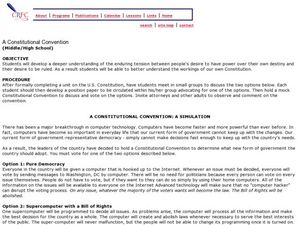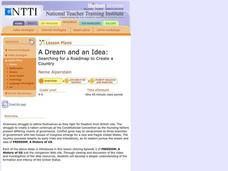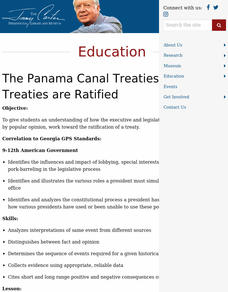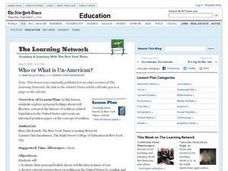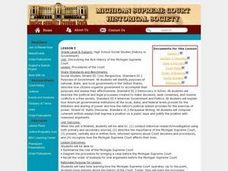Curated OER
Representing Our Nation
Students use pennies to illustrate how our states are represented in Congress. This lesson is to be implemented during a unit covering the branches of United States government.
Curated OER
US Constitution And Amendments
Students become familiar with the US Constitution and consider how it affects their lives. They research the Preamble to articulate the purposes of government, compile collages, and research the separation of powers within each branch of...
Curated OER
Life before Congress
Pupils name some interesting backgrounds of Members of Congress, identify their current representatives in the legislative branch of the national government, and describe the background of one local representative or senator.
Curated OER
A CONSTITUTIONAL CONVENTION: A SIMULATION
Students discuss two computerized options to change the current U.S. government. In this Constitutional Convention lesson, students write a statement advocating for one of the choices and participate in a mock modern Constitutional...
Curated OER
Potus and PowerPoint
Fifth graders research a president of the United States and create a PowerPoint presentation. They demonstrate their knowledge of the executive branch of our government and use the Internet to conduct their research for their PowerPoint...
Curated OER
Civics: State Vs. Rowe
Students examine the case of State vs. Rowe to discover the duties of the three branches of government. They explore the concepts of separation of powers and checks and balances to assess how they apply to an actual situation.
Curated OER
A Dream and an Idea: Searching for a Roadmap to Create a Country
Students compare and contrast opposing visions of government held by the founding fathers. They evaluate the roles of historical leaders in shaping the U.S. as an emerging nation.
Curated OER
The Panama Canal Treaties: How Treaties Are Ratified
High schoolers gain an understanding of how the executive and legislative branches, influenced by popular opinion, work toward the ratification of a treaty. They examine the influences and impact of lobbying and special interests in the...
Curated OER
Asking and Answering Questions Using the Balance of Powers
Learners complete a diagram showing the relationship between the executive, legislative and judical brances of the government. They form sentences using the question words. They restate who and what questions as well.
Curated OER
Wisconsin History and Information
Fourth graders complete a multi-faceted project about the people, places, and government of Wisconsin. Working with traditional and technological resources, they research various topics related to the history of Wisconsin and create a...
Curated OER
The Formation and Function of the Supreme Court
Learners analyze the role of the U.S. Supreme Court. They read a handout and Article III, section 1 of the Constitution, analyze and rate by relevance noteworthy Supreme Court cases, and write how they decided each rating.
Curated OER
Heroes, Elders, Historic Figures, Contemporary Tribal Leaders
Fifth graders research famous Elders. They receive a list of Elders, Historic Figures and Contemporary Tribal Leaders (included with the lesson plan). They discuss the Essential Question to guide their research. Students take notes based...
Curated OER
The life of a legislative bill
Young scholars investigate bills under consideration by the United States Congress and create a flow chart that tracks the movement of the bills to gain understanding of the legislative process.
Curated OER
Checks and Balances: Japanese-American Incarceration
Students examine the three branches of the Federal Government and their decision to place Japanese-Americans in camps during World War II. They analyze debates made by leaders during this time period.
Curated OER
The Right to Remain Resilient
Students examine the Civil Rights Movements in the U.S., both current and historic. In small groups students investigate a specific civil rights group, create an illustrated timeline, noting key events, people, and state and federal laws.
Curated OER
Re-Examining Brown
Students explore and describe the impact of segregation on African Americans and other non-white minorities. In this segregation lesson students identify, research and report on the legal cases that led to the Brown vs. Board of...
Curated OER
Michigan Judicial System Conclusion
Middle schoolers identify the courts that make up Michigan's judicial system. They state the responsibilities of each court and diagram a flow chart of how a case moves to the Michigan Supreme Court. They participate in a quiz about the...
Curated OER
dsfa
Students work in groups examining the school's policy of no weapons on school property.
Curated OER
Who or What is Un-American?
Students explore concepts about civil liberties, research the history of sedition-related legislation in the U.S. and create a position paper on the topic.
Curated OER
Differences and Settlement in the Legislative Budget Process
Students discuss the issues at hand when legislators are trying to agree on policy. In groups, they role-play different roles within a sub-committee when trying to balance the budget. They present their findings to the class and...
Curated OER
Procedures of the Court
Students examine the role of the Michigan Supreme Court. They diagram the procedure one must follow to bring a case before the Court. They discuss the order of business for oral arguments as well.
Curated OER
Michigan United Conservationists Club (M.U.C.C). v. Michigan Secretary of State: An Issue of Referendum
Students observe the procedures of the Michigan Supreme Court. They identify the processes and procedures being used. They debate a case that was presented to the Court and analyze the oral arguments of the case.
Curated OER
Michigan Court System (Part 1) (Middle School)
Pupils identify the courts that make up the Michigan judicial system. They explore the responsibility of each court and diagram how cases move to the Supreme Court. They compare and contrast the different types of courts.
Curated OER
History of the Michigan Supreme Court from the Territorial Court and the founding of the Michigan Supreme Court in 1836 to Justice Mary S. Coleman and her interpretation of "One Court of Justice"
Students trace the history of the Michigan Supreme Court from when the state was still a territory. They define procedures as they relate to the Court. They compare and contrast the territorial court to the new Court.
Other popular searches
- Branches of Government
- Three Branches of Government
- 3 Branches of Government
- Branches of Government Chart
- Branches of u.s. Government
- Branches of Us Government
- The Branches of Government
- U.s. Government (Branches)
- Us Government Branches
- Federal Government Branches
- State Branches of Government
- Branches of Federal Government



